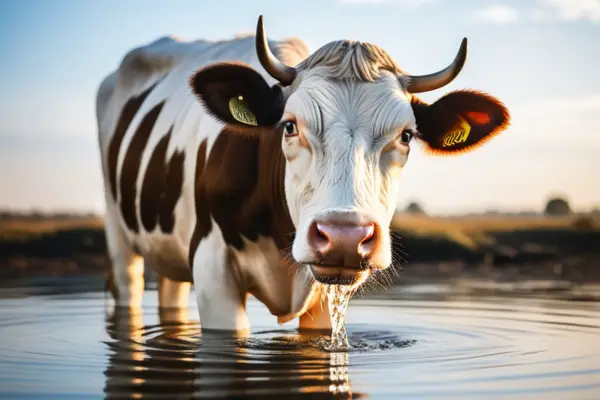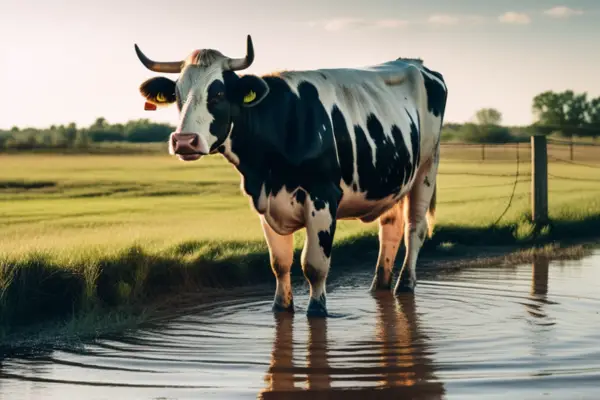Water Requirements for Beef Cattle
Ensuring beef cattle have access to clean, fresh water is one of the most important aspects of cattle management. Water is essential for almost all bodily functions – from regulating body temperature to aiding in digestion and nutrient absorption.
Without adequate water intake, cattle growth, health, and productivity rapidly decline. This article will cover the basics of water needs for beef cattle operations, including recommended quantities, water quality considerations, and best practices for providing sufficient access to water sources.
How Much Water Do Cattle Need?
Determining the exact water requirements for beef cattle can vary somewhat depending on factors like weather, diet, and stage of production. However, most beef cattle require between 3 to 30 gallons of fresh water per day.
For example, a 1,200 pound lactating beef cow needs about 20 gallons of water daily when the weather is hot in places like Texas. This accounts for needs associated with milk production, metabolism, respiration, waste elimination, and daily maintenance.
Typically, daily water intake directly correlates to dry matter intake. The common recommendation is about 3 gallons consumed per 100 pounds of feed consumed by beef cows and 1.5-2 gallons per 100 pounds of feed for stocker cattle on high roughage diets. Higher temperatures, lactation, and even some dietary factors can increase daily water needs.
For example, feeding cattle higher salt diets requires providing more fresh water access to account for increased thirst and urination.
On hot summer days, water requirements can dramatically jump up to 2 to 3 times normal averages. Lactating beef females also have around 20-50% higher total water needs associated with milk production over their dry counterparts.
Generally, younger nursing beef calves need about 2 gallons of water per 100 lbs of body weight during summer temperatures. Care should be taken to ensure their small body size doesn’t limit their intake capacity compared to mature cattle.
Water Quality Considerations
While water quantity is critical, water quality also plays a huge role in proper hydration. Contaminants like bacteria, heavy metals, sulfur, and sediments can all decrease palatability and intake. In some cases, higher sulfur or salt levels can even contribute to polioencephalomalacia.
Regular water testing, at least annually, can help monitor for developing issues before they negatively impact health or performance.
Common water tests for cattle include measuring pH, hardness, iron content, nitrates, sulfates, and salinity levels. Bacterial testing for E. coli and other infectious pathogens is also recommended.
Water hardness and pH outside the normal ranges can decrease intake and availability of some minerals. High sediment load from erosion or algae growth can also contribute to reduced palatability and consumption.
Contamination from minerals like iron, manganese, sulfate, chloride, and magnesium all have maximum tolerable concentrations. If these thresholds are exceeded for extended periods, poisoning and toxicity can occur.

Providing Adequate Water Access
Along with water quality, having adequate access to water sources is equally important in cattle operations. Limiting access through poor placement, overcrowding, faulty equipment or other barriers to water sources greatly increases risks to cow health and performance.
Inadequate water consumption is a main culprit in downward spiraling cattle body condition and productivity. Decreased water intake contributes to poorer feed conversions, less available nutrients, and higher susceptibility to metabolic disorders like ketosis.
Severe dehydration also taxes critical organ function in the kidneys and liver and decreases blood flow to the digestive tract.
Providing at least 3 linear inches of water tank access per cow is recommended to avoid competition at the water source. Smaller tank openings or restricted access prevents lower ranked cattle in the social hierarchy from drinking frequently enough. During hot weather, when drinking frequency increases, this requirement may jump to over 9 inches per animal.
Water tanks should be kept clean and checked daily to make sure water is readily available with adequate flow rates of at least 8-10 gallons per minute. Placing additional water sources in locations requiring long walks is also advised to stimulate increased movement and intake.
The recommended temperature for cattle drinking water sources is 50 to 65°F, which encourages optimal consumption levels year round. Addressing leaks or other equipment issues that restrict adequate access to clean water for cattle should be top priority.
Conclusion
Fresh, clean water is absolutely vital to maintaining beef cattle health and productivity. From milk production in beef breeding herds to finishing stocker steers, water is essential to critical bodily functions. While individual needs vary slightly based on age, weather, diet, and stage of production, most beef cattle require 3 to 30 gallons of water per day.
Along with adequate quantity, providing high quality water and sufficient access to sources is equally important to support normal cattle water intake.
Contamination from pathogens, heavy metals, sediment, sulfur, and other substances can all reduce palatability or pose other health risks if consumed long-term. Regular water quality testing detects developing issues like high iron or nitrates before cattle productivity is impacted.
Finally, allowing ample linear space per animal, multiple water locations, recommended flow rates, cool water temperatures, and prompt equipment repairs are all best practices cattle operations should follow.
Paying close attention to these core water provision recommendations is key to avoiding decreased growth performance, malnutrition, or health issues related to inadequate hydration. Monitoring water availability and making adjustments to meet dietary water needs should be standard protocol for all beef cattle production systems.


